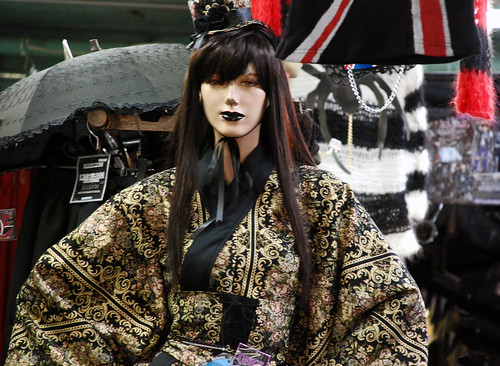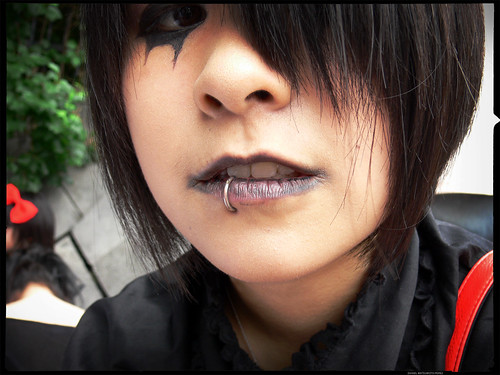Sunday, December 09, 2007
Three of a Kind
You really do get to see them all in Harajuku.
The one on the left would only be photographed if she was touching her face in some way.
Monday, November 05, 2007
Monday, October 08, 2007
JAPANESE STREET FASHION
TOKYO FASHION
There were some very distinct fashion trends for young women in Tokyo this Spring.
Denim jackets and skirts - Never worn together, but a short denim jacket would be worn over a dress or t-shirt with pants in a wide range of lengths from the very short to full length in either army green or camouflage.
Below the knee length boots were very common, worn with shorts or dresses, but with bare legs. Stocking socks were worn with the boots, more frequently showing than hidden at the top. The styles of boots varied greatly, as I don't think I ever saw any the same.
Many boots were a cowboy style, but with a high pointed heel. Others had patterns on the side or fancy laces. Black was not a common color.
TOKYO FASHION - LOCATIONS
Harajuku
Possibly the new centre of fashion in Tokyo, from the latest in young fashion to extreme fashion Gothic Lolita.
Ginza
It is considered the fashion area of the Tokyo and contains many up market shops and restaurants.
Odaiba
A popular shopping and sightseeing destination for Tokyoites and tourists alike.
Shinjuku
A key fashion shopping and nightlife part of Tokyo.
Ropongi
Famous for its nightlife where thousands of foreigners are visible. Almost all restaurants and clubs cater to the English-speaking crowd.
Shibuya
The trendy part of Tokyo, where you can see the latest and often outrageous fashion.
TOKYO FASHION - DISTINCT STYLES.
Kogal
A subculture of girls and young women in urban Japan. They are characterized by conspicuously displaying their disposable incomes through unique tastes in fashion, music, and social activity.
Gothic Lolita
Gothic Lolita or GothLoli is a Japanese youth fashion among Japanese teenagers and young women. It emphasizes Victorian-style girl's clothing and often aims to imitate the look of Victorian porcelain dolls.
Gonguro
Ganguro, literally "black-face", is a Japanese fashion trend among many Japanese girls which peaked in popularity from the late 1990s.
Meeting People in Japan
Whether you're planning to come to Japan or have already arrived, the more people you know here the easier it will be to settle in. You may be looking to expand your social circle, get into a sport or hobby, even find a girlfriend or boyfriend. All of the above are easier if you speak the language but lots of people manage to get by without it. There are plenty of clubs, associations and parties catering to foreigners, mainly English-speaking ones, and there's no end of Japanese who are keen to hook up with you - for all kinds of reasons. Of course if you're the super-sociable type, just being out and about enjoying the multitude of distractions that Japan has to offer, during daylight hours and after dark, will probably be enough for you to meet lots of people. Otherwise, you may want to take advantage of some of the services set up by those of a more enterprising nature.
Most of the big cities have at least one area where the nightlife is particularly "hot." But none can compare to Tokyo's Roppongi district. Originally home to many of the ex-patriate community working at embassies and foreign companies in the area, it became more of a "meat market" as the English teaching hordes arrived in the 80s. The more popular bars and clubs are filled to bursting on weekend nights and many party through to the following morning. Basically a great place for the young, free and single but "relationships" tend to be, how can I put this - fleeting. As the number of westerners has grown over the years, more and more of them have opened bars and restaurants which have become gathering places for fellow "gaijin" and japanese who like to hang out in a more international atmosphere. One example is the growing number of Irish pubs that have sprouted up all over the country, especially in and around Tokyo.
In the real world there is enough of a foreign population in Japan these days for just about every sport or common hobby to be accessible in English. There are clubs for things as diverse as softball rugby, martial arts dojos, flower arrangement, amateur radio, swing dance and foot fetishists. Most countries have their own society or network, many of which are online, too. There's just too much for me to try and list them all here and keep them updated. Your best bet is to check the free classified magazines that are circulated in most big cities. Some clubs as well as the magazines themselves organize regular international parties.And of course there is always good old daily life. Japanese people, in the cities anyway, have become much more used to seeing foreigners. The result can be good or bad depending on how you look at it; people are less likely to run away or try to avoid you if you approach them but, strangely enough, they are also less likely to strike up a conversation with you, unless they're drunk! For the many people who come to Japan to teach English, there is regular contact with students and staff. If the students are adults and the school doesn't specifically prohibit socializing with them (as NOVA does, for example), you can expect them to be very happy to go out drinking with you.
A relationship, with a Japanese person or anyone else for that matter, will have its ups and downs. If it's a Japanese person, there may be cultural and/or language issues that crop up now and again.
Monday, October 01, 2007
Tuesday, September 25, 2007
Harajuku Summer Fashion
You wouldn’t say that from looking at the fashion seen on the streets, though. No shorts and tank-tops on Osaka’s streets. People dress as carefully as always.
Especially popular this Summer is leggings (spats) in combination with dresses or skirts (see photo). I have only been able to shoot three people wearing this combination so far, but surely many will follow as the trend seems to be everywhere.
Another trend seems to be that brands are making a big comeback. I found fewer used clothes than before and more big brands.
Click on the photo to see all photos of this month’s shoots.
The beginning of Harajuku Street Style
Through the next two decades a variety of tribes (zoku) appeared, disappeared and re-emerged, styles came and went, but it's fair to say that nothing really radical ever stood out and made history.
The early 80's were more significant, a new kind of intellectual gothic wave of music and fashion took over Harajuku., 'Shojo Stuff, Virtual Pure Girl' (related to the, controversial for some, otaku culture) adopted the French dolls fashion to create 'Loli Goth'.
You might have heard of LaForet Shopping Center, since back in 1978 it has made itself the prime outlet source for the innovative and latest Harajuku street fashion. A fantastic variety of Lolita Goth clothing is specifically sold by LaForet Boutique.
The beginning of the 90s saw a remarkable change in the way that youth dressed, an avant-guard subculture was starting to appear on the most fashionable streets of Tokyo.
Harajuku was soon at the forefront of any other fashion district emerging as the most assertive and innovative place where street culture and individualistic creativity enjoyed complete freedom from the limitations of the traditionally conformist japanese society.
In 1996 photographer Shoichi Aoki launched the fanzine Fruits which became 'the look' bible of the style fashion tribes.
'I am gonna get my picture in Fruits' was forged as the highest fashion achievment statement of Harajuku wanna be style guru
The end result, East abruptly merged with West pop culture adopting and redifined the british punk idea, leather gear, studs and goth clothing were individually customized, even the more traditonal kimono had a street style re-launch . Doc Marten boots, second hand self tailored military garments also found a place in the imagination of Harajuku amateurish designers.
On Sundays, the Station area, Yoyogi Park, and the notorious Takeshita Street, paraded the most amazing make up looks and costumes displayes. A complete transformation of the ideal model of youth fashion and anti-conformistic Japanese aesthetics took over the sub urban district transforming Harajuku into a mecca of style innovation.
Japanese Steet Fashion it's not limited to Tokyo it has become a nationwide idea, but it doesn't end there, it has followers from all over the world , Cosplay in particular (costum play) has long established stongholds in Europe and the USA .
Harajuku lovers follow the more extravagant and sometime outrageously extreme Japanese street fashion.
The innovative characters of Harajuku are today the masters from whom known designers bow and look to for the ultimate inspiration. It's a fact that known commercial enterprises often take Harajuku 's young people fashion ideas and turn them in to their 'own' high street fashion .
Harajuku smart 'kids' are mostly well mannered and do not seem to have any cash flow problem, their costumes are an elaborate piece of expensive artifice which they are quite happy to display and pose for your camera snap adopting a pre-format and prepared look, but you better be quick, the magic is not to last, a polite smile and soon they are back to fade in the colorful Harajuku crowd.
Monday, September 17, 2007
Thursday, September 13, 2007
Thursday, August 16, 2007
Harajuku Up & Close
HARAJUKU is well-known as fashion Street of Tokyo. A shopping and entertainment district for the young and trendy. HARAJUKU first burst onto the scene in 1964 - the Olympic year. HARAJUKU's fashion is an extraordinary blend of goods reflecting the Japanese notions of "cute", "cool and American" and "rebellious and British". In other words a strange mixture of Hello Kitty, Disney, hip-hop and the infamous British punk and fancy dresses.
Wednesday, August 08, 2007
Saturday, August 04, 2007
Sunday, July 08, 2007
harajuku ; cried enough
no rules, no limitations, no boundaries it's like an art
HARAJUKU GIRL are the New GEISHA
harajuku written but not pronounced
no rules, no limitations, no boundaries it's like an art
HARAJUKU GIRL are the New GEISHA
Monday, July 02, 2007
Street Fashion in Harajuku
Uploaded by drone207a on 11 Jun 07, 7.44PM ICT.








































